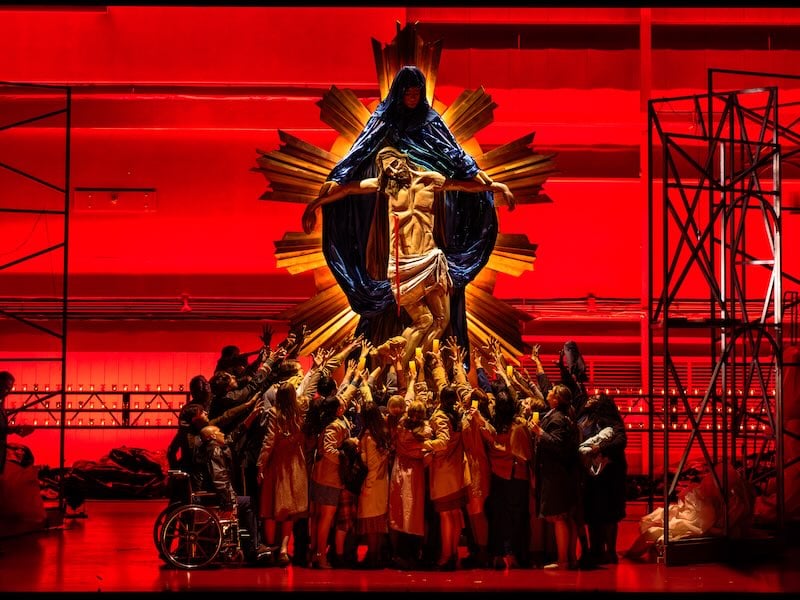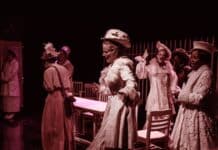This is a Tosca to die for. Opera aficionados who have seen this production, part of Glimmerglass’ 50th Anniversary season, are already comparing it to other productions — that is what opera lovers do, after all — and several who spoke to me said this is the best they’ve seen. I concur.
The world in this opera by the great Italian composer Giacomo Puccini is on fire. Civil war has broken out. Bullies and thugs have seized power. The rule of law is gone. It is a world where children are bullied and women are compromised and forced to submit to depraved, insatiable lechers. It is a world where even the church can offer no sanctuary but where terrified people are dragged from their hiding places and “disappeared.” The love of power has all but replaced the power of love, and empathy for our fellow man is scorned. As our great contemporary historian Jon Meacham has addressed the precarious situation we find ourselves in today, which offers some parallels, “We are in a battle for the soul of our country.”
Against a backdrop of political terror and chaos, a painter paints and a singer sings.

Director Louisa Proske, who hails from Berlin, knows well the scarred history of her own country’s not-so-distant past and has brought her considerable forces together to get a bead on questions at the heart of this opera. What do we do in the face of chaos and evil? What should artists do so as not to collude? And what role can they play to resist, help lead us through, and, to quote Meacham again, find “our better angels”?
Set Designer John Conklin, who designed the productions for the entire Glimmerglass Anniversary season, in Tosca continues his visual linkage of the works so that they might resonate and “be in conversation” with one another by threading through all his choice of thematic red. It put me in mind of another show’s anthem for young men in a time of revolution: “Red, the blood of angry men… Red, the color of desire…,” etc. With Conklin’s passing just before the season opened, the Festival has dedicated the season to him.
What would a grand opera be without grand voices? In the case of this Tosca, the three leads are at the top of their game, and all three have been featured this past season at the Met. Yongzhao Yu is our hero, Mario Cavaradossi, a painter commissioned to paint a penitent Mary Magdalena for the cathedral. Yu embodies opera’s heroic tenor with his ardent vocal power giving full expression to some of the most beautiful melodic writing Puccini composed for a tenor. Yu also rises to the acting challenges of the role, demonstrating in turn the loyal revolutionary comrade and friend to Angelotti, the disciplined artist who continues to work under enormously stressful conditions of wartime, the tender and reassuring wooer to a jealous and high-maintenance diva, then a most courageous hero enduring torture and facing his own execution.
As the Diva that Mario adores, Michelle Bradley is, if anything, even more glorious vocally. Bradley possesses the power of a world-class soprano with seemingly that extra gear that enables her to soar out and above an entire orchestra. But she also shows the control to reel everything into a gossamer yet expressive pianissimo as she does throughout, but particularly in that most beautiful of Puccini’s arias, “Visi d’arte.”
There is a quintessential third role in the story, that of Scarpia, perhaps the greatest, most unscrupulous and rapacious villain in all of opera. Greer Grimsley seems born to have portrayed his darkness. It is the role of Scarpia that makes for the tight dramatic structure that builds to the thrilling climactic showdown in the second act. Grimsley portrays the oily unctuousness that changes in a moment to steely cruelty.
Proske prepares us for the big, dramatic payoff in her radical approach to the setting of Act II. Gone is any traditional office for Scarpia in the grand Farnese Palace with an ornate wooden desk and accoutrements of wealth and power associated with Scarpia’s world. Instead, we find ourselves in a military camp barracks made of cinder block and crenelated metal walls. At the top of the act, a young woman lies on a narrow bed in the office, exhausted or passed out, one is left to imagine, by only the latest forced sex by Scarpia. Stage right in full view of the audience is a tiled institutional bathroom, its walls slightly moldy. One of Scarpia’s henchmen is taking a piss. Later, another Blackshirt comes in and vomits from the horror of witnessing Mario being tortured. Even the final act of violence is staged in this most ignominious of settings. Spoiler alert: the opera doesn’t end well.
Glimmerglass productions are always marked by rich collaborations between top-notch design teams. The designers for Tosca have wrought something that surpasses anything I’ve seen there in the almost 13 or 14 seasons I’ve been coming. Conklin’s set design was greatly aided by his associate, James Rotondo. Robert Wierzel, lighting designer, did a bang-up job for The Rake’s Progress this season, but his painting with light for this magnificent Tosca, especially Act I, which glows like a burnished Old Master’s painting, surpassed all. Kaye Voyce designed the costumes, and they too glowed as grand opera should. Tom Watson, hair and make-up designer for all the shows, is a stalwart member of the Glimmerglass design team and enhanced each character’s definition from the emaciated look and ragged locks of the battle-fatigued Angelotti to the glamorous tresses for the star, Floria Tosca.
Presiding over all for this production is Conductor Joseph Colaneri, who seemingly breathes Italian opera. His acute understanding of Puccini makes this Tosca a most fully realized and life-affirming experience of the power of great art.
Tosca (plays through August 16, 2025)
Running Time: Two hours and 21 minutes with a 25-minute intermission.
Conductor – Joseph Colaneri
Stage Director – Louisa Proske
Set Designer – John Conklin
Associate Set Designer – James Rotondo
Costume Designer – Kaye Voyce
Lighting Designer – Robert Wierzel
Projected Titles – Kelley Rourke
Fight Director – Thomas Schall
Sound Designer – Joel T. Moran
Hair & Makeup Designer – Tom Watson
Floria Tosca – Michelle Bradley
Mario Cavaradossi – Yongzhao Yu
Scarpia – Greer Grimsley
Cesare Angelotti – Donghoon Kang
Sacristan – Sergio Martinez
Spoletta – Kellan Dunlap
Sciarrone – Luke Harnish
Treble Solo – Ian Clark
Jailer – Jeremy Harr
Tickets are available at glimmerglass.org.
SEE ALSO:
2025 Glimmerglass Festival Review: ‘Sunday in the Park with George’ and ‘The House on Mango Street’
2025 Glimmerglass Festival Review: ‘The Rake’s Progress’
(reviews by Susan Galbreaith)



